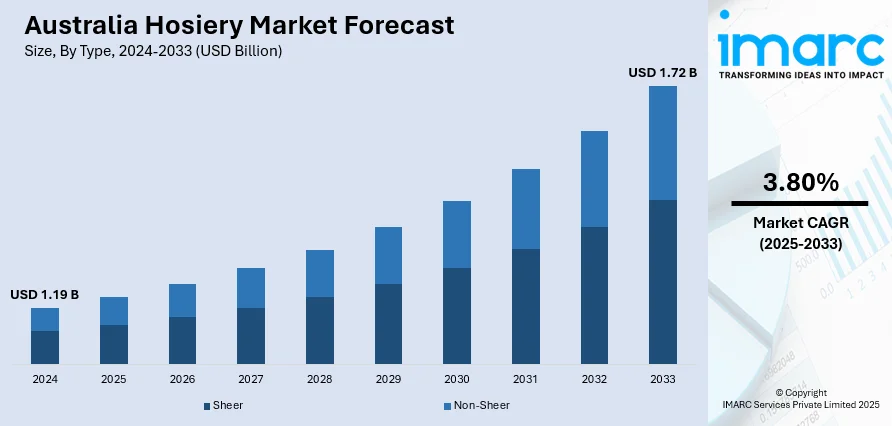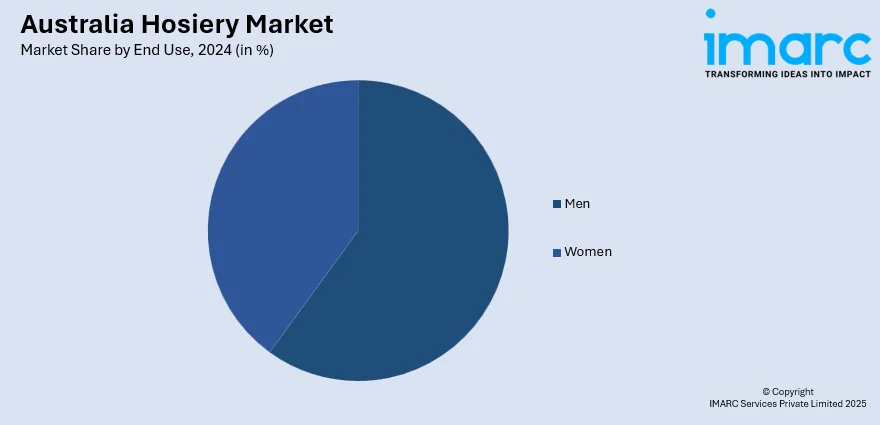
Australia Hosiery Market Size, Share, Trends and Forecast by Type, End Use, and Region, 2025-2033
Australia Hosiery Market Overview:
The Australia hosiery market size reached USD 1.19 Billion in 2024. Looking forward, the market is projected to reach USD 1.72 Billion by 2033, exhibiting a growth rate (CAGR) of 3.80% during 2025-2033. The market is driven by the growing demand for hosiery that balances style with everyday comfort and wearability. E-commerce platforms are transforming consumer access to personalized, value-driven hosiery, while private label brands are expanding product diversity, thereby fueling the market. Rising health consciousness is further encouraging the adoption of functional and compression hosiery, thus augmenting the Australia hosiery market share.
|
Report Attribute
|
Key Statistics
|
|---|---|
|
Base Year
|
2024
|
|
Forecast Years
|
2025-2033
|
|
Historical Years
|
2019-2024
|
| Market Size in 2024 | USD 1.19 Billion |
| Market Forecast in 2033 | USD 1.72 Billion |
| Market Growth Rate 2025-2033 | 3.80% |
Key Trends of Australia Hosiery Market:
Shifting Consumer Preferences Toward Functional and Fashionable Hosiery
Australian consumers are increasingly seeking hosiery that blends aesthetics with performance. The shift in lifestyle toward casual professional attire and fashion-forward loungewear has led to growing demand for stylish tights, compression socks, and sheer pantyhose designed for both work and leisure. Retailers are responding with expanded ranges featuring breathable materials, temperature control, and moisture-wicking fabrics. Local and international brands are also promoting hosiery lines through influencer campaigns, social media styling guides, and collaborations with designers, ensuring higher consumer engagement across younger demographics. Seasonal trends, such as layering during winter or pairing hosiery with open footwear in transitional weather, further fuel product demand across metropolitan areas. Additionally, inclusivity in size offerings and nude shade diversity have broadened market reach among women across ethnicities and body types. Hosiery is increasingly positioned as a wardrobe essential rather than a niche item, particularly among professionals, performers, and active consumers. In 2025, the Australian tights and leggings market is projected to generate a revenue of AUD 217.48 Million (about USD 142.4 Million), with a steady annual growth rate of 0.73% through 2029. The average revenue per capita in the market is expected to reach AUD 8.06 (approximately USD 5.31), with the volume of tights and leggings estimated to reach 17.9 million units by 2029. The growing fusion of fashion with utility and comfort is strongly influencing purchasing decisions and long-term brand loyalty. These multifaceted shifts collectively support Australia hosiery market growth as brands adapt their portfolios to evolving wearability standards and consumer lifestyle needs.

To get more information on this market, Request Sample
Health and Wellness Trends Driving Functional Hosiery Demand
The rising focus on personal health and wellness across Australia has fueled interest in medical-grade and performance-enhancing hosiery. Compression stockings, widely used to improve circulation, reduce fatigue, and manage venous conditions, are gaining acceptance beyond clinical use. A study revealed that compressive pantyhose (CP), with a pressure of 20–30 mmHg and made of 73% polyamide and 27% elastane, showed no significant decrease in performance in the Standing Heel-Rise Test (SHRT), where participants performed 30.2 ± 6.0 repetitions. In comparison, placebo pantyhose (PLA), made of 85% polyamide and 15% elastane, showed a significant decrease to 22.9 ± 6.3 repetitions at 30 minutes post-test. Athletes, travelers, nurses, and pregnant women are adopting functional hosiery for daily use, contributing to segment diversification. Pharmacies and health-focused retail chains now offer varied compression levels, styles, and materials catering to both therapeutic and preventive needs. Health professionals increasingly recommend compression hosiery to mitigate swelling and deep vein thrombosis (DVT), especially for aging populations and sedentary workers. Marketing efforts have shifted toward positioning hosiery as a wellness accessory, emphasizing ergonomic fit, comfort bands, and targeted support zones. Consumer education, through both healthcare providers and online channels, is also helping overcome misconceptions about compression wear being exclusively medical. Product development is converging with wellness goals, driving innovations in seamless knitting, anti-microbial fabrics, and smart textiles embedded with biometric sensors. This fusion of comfort, technology, and healthcare functionality is redefining hosiery’s role beyond fashion and performance, unlocking new market segments across Australia.
Growth of Athleisure and Compression Wear
The development of fitness and wellness culture has greatly impacted the hosiery industry in Australia. People are increasingly being drawn to multigrid products that combine style, comfort, and functionality. Compression leggings and socks and sport-inspired stockings are being adopted by athletes and people focusing on daily health and active lifestyles. These products enhance circulation, reduce fatigue, and support muscle recovery, and therefore, they are of appeal to a wide base of customers. Further. the addition of athleisure to casual and business attire has eliminated the distinctions between sportswear and regular fashion. This trend is enhancing Australia hosiery market demand, with brands innovating in breathable fabrics, seamless designs, and moisture-wicking technology to cater to the changing expectations of consumers.
Growth Drivers of Australia Hosiery Market:
Growing Sustainability Preferences
Sustainability has emerged as a crucial factor in transforming the hosiery market in Australia. Consumers are increasingly on the lookout for eco-friendly choices, prompting brands to explore the use of organic cotton, bamboo fibers, and recycled materials. The push toward biodegradable packaging and ethical manufacturing practices is also gaining momentum, aligning with the broader sustainability initiatives in the country. Younger consumers, in particular, are inclined to pay a bit more for products that reflect environmental responsibility. This shift is encouraging both established and new hosiery brands to weave green initiatives into their operations. Consequently, sustainable hosiery has transitioned from being a niche category to a significant growth opportunity, enhancing long-term value in the market while addressing changing consumer demands.
E-Commerce Expansion
The rapid increase in online shopping has served as an important driver for hosiery sales in Australia. Digital platforms provide consumers with a broader range of products, from everyday necessities to high-end, fashion-forward designs. Attributes such as size variety, style filters, and customization options greatly improve convenience and accessibility. The emergence of direct-to-consumer brands and subscription models is further streamlining hosiery purchases. According to Australia hosiery market analysis, e-commerce channels are gaining a larger share of sales as they offer competitive pricing, swift delivery, and customer reviews that affect buying choices. This trend toward online retail is projected to continue, fueled by increasing digital adoption and changing consumer shopping habits.
Shift Toward Premium Products
Australia’s hosiery market is experiencing a growing demand for premium and branded products, driven by rising disposable incomes and lifestyle enhancements. Consumers are now placing greater importance on quality, durability, and comfort, rather than just price, which is leading to the introduction of luxury hosiery lines. Premium offerings typically showcase advanced fabric technologies, seamless finishes, and chic designs that attract both fashion-forward individuals and professionals in search of long-lasting options. Brand loyalty is becoming increasingly evident, as customers associate premium hosiery with trustworthiness and exceptional performance. Additionally, the culture of gifting and the growing influence of fashion trends on social media are contributing to the expansion of this market segment. The movement toward premiumization is enhancing profit margins for brands while diversifying the competitive landscape of the market.
Australia Hosiery Market Segmentation:
IMARC Group provides an analysis of the key trends in each segment of the market, along with forecasts at the country and regional levels for 2025-2033. Our report has categorized the market based on type and end use.
Type Insights:
- Sheer
- Non-Sheer
The report has provided a detailed breakup and analysis of the market based on the type. This includes sheer and non-sheer hosiery products.
End Use Insights:

- Men
- Women
The report has provided a detailed breakup and analysis of the market based on the end use. This includes hosiery products for men and women.
Regional Insights:
- Australia Capital Territory & New South Wales
- Victoria & Tasmania
- Queensland
- Northern Territory & Southern Australia
- Western Australia
The report has also provided a comprehensive analysis of all major regional markets. This includes Australia Capital Territory & New South Wales, Victoria & Tasmania, Queensland, Northern Territory & Southern Australia, and Western Australia.
Competitive Landscape:
The market research report has also provided a comprehensive analysis of the competitive landscape. Competitive analysis such as market structure, key player positioning, top winning strategies, competitive dashboard, and company evaluation quadrant has been covered in the report. Also, detailed profiles of all major companies have been provided.
Australia Hosiery Market News:
- On July 25, 2024, Victoria’s Secret announced the opening of its third full-assortment store in Melbourne, Australia, located at the Highpoint Shopping Centre. The new store will feature an open-concept layout, enhanced fitting rooms, and offer a range of products including bras, panties, sleepwear, hosiery and beauty items. This expansion follows the brand's 2023 flagship store opening at Pacific Fair Shopping Centre on the Gold Coast, marking a significant growth in Victoria’s Secret's retail presence in the Australian market.
Australia Hosiery Market Report Coverage:
| Report Features | Details |
|---|---|
| Base Year of the Analysis | 2024 |
| Historical Period | 2019-2024 |
| Forecast Period | 2025-2033 |
| Units | Billion USD |
| Scope of the Report |
Exploration of Historical Trends and Market Outlook, Industry Catalysts and Challenges, Segment-Wise Historical and Future Market Assessment:
|
| Types Covered | Sheer, Non-Sheer |
| End Uses Covered | Men, Women |
| Regions Covered | Australia Capital Territory & New South Wales, Victoria & Tasmania, Queensland, Northern Territory & Southern Australia, Western Australia |
| Customization Scope | 10% Free Customization |
| Post-Sale Analyst Support | 10-12 Weeks |
| Delivery Format | PDF and Excel through Email (We can also provide the editable version of the report in PPT/Word format on special request) |
Key Benefits for Stakeholders:
- IMARC’s industry report offers a comprehensive quantitative analysis of various market segments, historical and current market trends, market forecasts, and dynamics of the Australia hosiery market from 2019-2033.
- The research report provides the latest information on the market drivers, challenges, and opportunities in the Australia hosiery market.
- Porter's five forces analysis assist stakeholders in assessing the impact of new entrants, competitive rivalry, supplier power, buyer power, and the threat of substitution. It helps stakeholders to analyze the level of competition within the Australia hosiery industry and its attractiveness.
- Competitive landscape allows stakeholders to understand their competitive environment and provides an insight into the current positions of key players in the market.
Key Questions Answered in This Report
The hosiery market in Australia was valued at USD 1.19 Billion in 2024.
The Australia hosiery market is projected to exhibit a compound annual growth rate (CAGR) of 3.80% during 2025-2033.
The Australia hosiery market is expected to reach a value of USD 1.72 Billion by 2033.
The Australia hosiery market is witnessing growing demand for athleisure-inspired hosiery, stylish fashion patterns, and sustainable fabric innovations. Online retail is reshaping consumer access, while premiumization is also driving brand loyalty.
Rising fashion awareness, health-conscious lifestyles, and increased disposable incomes are fueling hosiery demand in Australia. Furthermore, the emphasis on comfort, durability, and performance is accelerating consumer preference for high-quality hosiery across segments.
Need more help?
- Speak to our experienced analysts for insights on the current market scenarios.
- Include additional segments and countries to customize the report as per your requirement.
- Gain an unparalleled competitive advantage in your domain by understanding how to utilize the report and positively impacting your operations and revenue.
- For further assistance, please connect with our analysts.
 Request Customization
Request Customization
 Speak to an Analyst
Speak to an Analyst
 Request Brochure
Request Brochure
 Inquire Before Buying
Inquire Before Buying




.webp)




.webp)












